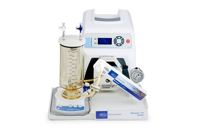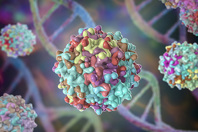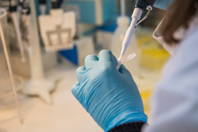FEATURED EDITORIAL
New chief editor of Drug Discovery Online shares insights from BIO 2025’s global biotech gathering and spotlights the impacts to early-stage drug research.
- Formulation Development Of A JAK1 Inhibitor Extended-Release Tablet
- A Guide To Designing mRNA Medicines
- Bracing For The Impact Of The Federal Workforce Reduction
- Radiopharmaceuticals: Navigating FDA Guidance And CMC Considerations
- Designing Our Way Toward Circular RNA Medicines With AI
- Will Genome Modifications Define Next-Gen AAV Vectors?
- Formulation Is Key For Y-mAbs' Self-Assembling Antibody
FEATURED APPLICATION CONTENT
-
Decarbonizing healthcare and pharmaceuticals is vital to meet climate goals and safeguard public health. Learn why these energy-intensive sectors must act swiftly to reduce emissions and navigate complex global supply chains.
-
Optimize your protein purification workflow with tangential flow filtration by comparing membrane performance and exploring how protein concentration impacts flux and MWCO selection in lab-scale systems.
-
Raman spectroscopy has revolutionized manufacturing through real-time monitoring. Explore a system that enables a seamless calibration model transfer from small- to large-scale bioreactors to enhance scalability and efficiency.
-
Adeno-associated virus is a key gene therapy vector. Explore how digital PCR offers precise, standard-free quantification with improved consistency and inhibitor tolerance over traditional qPCR methods.
-
Digital PCR offers precise, inhibitor-resistant DNA quantification and genome integrity assessment. Discover how this method enhances accuracy and reproducibility, especially in AAV analysis, using multiplexed targets and Poisson-based calculations.
-
Sterility in injectable drug manufacturing is vital for patient safety and efficiency. Discover how biofluorescent particle counters revolutionize contamination control, regulatory compliance, and operational excellence in modern pharma.
-
Are robotic gloveless isolators the key to smarter, safer, scalable solutions? Discover how they can revolutionize aseptic filling by reducing contamination, minimizing waste, and enhancing manufacturing flexibility.
-
CDMOs must innovate production architectures to meet the demands of advanced therapeutics to ensure a reliable supply and compliance. Discover how these approaches advance modern medicine and improve patient outcomes.
-
Delve into the intricate workflow employed for the discovery and characterization of monoclonal antibodies (mAbs) targeting the Delta spike protein.
-
Overcoming the limitations of current proximity inducers requires optimizing cooperativity. Learn how enhancing target affinity can lead to smaller, more effective therapeutics with better safety profiles.
-
Maximize your research potential by overcoming workflow bottlenecks. This piece explores flexible strategies for increasing throughput and integrating automation seamlessly into your laboratory operations.
-
Continuous processes enhance product quality, yield, and cost savings. Explore transitioning a fed-batch process to perfusion using a small batch bioreactor system to optimize cell culture conditions and comparing performances.
FEATURED NEWS HEADLINES
- Grace Therapeutics Announces Submission Of New Drug Application To U.S. Food And Drug Administration For GTx-104
- Scientists Find New Way To Predict How Bowel Cancer Drugs Will Stop Working
- Adial Pharmaceuticals Secures U.S.-Based Manufacturing Through Agreements With Cambrex And Thermo Fisher Scientific For Drug Substance And Drug Product Supply
- CARsgen Therapeutics Announces NDA Acceptance Of Satri-cel By China's NMPA
- Riliprubart Earns Orphan Drug Designation In The US For Antibody-Mediated Rejection In Solid Organ Transplantation
- A Glowing Biosensor For High-Throughput Drug Screening
- Causaly Launches AI-Powered Competitive Intelligence Application For Research Scientists
- Enhanced Genomics And The ALBORADA Drug Discovery Institute Partner To Accelerate Alzheimer's Drug Discovery
- Axcelead DDP And Superluminal Announce The Intent To Collaborate On Drug Discovery Targeting Specific Molecular Mechanisms, Continuing A Productive Relationship
- XtalPi Announces Strategic Collaboration With Harvard Professor Gregory Verdine's DoveTree LLC To Advance Novel Therapeutics Using AI+Robotics Drug Discovery Platform
ARCHIVED NEWSLETTER
- 06.24.25 -- Protecting Intellectual Property In The Genomics Revolution
- 06.19.25 -- Your helping hand in filtration for high concentration drugs.
- 06.17.25 -- PheWAS Is Your Friend
- 06.11.25 -- From Complexity To Efficiency: The Future Of Drug Development
- 06.10.25 -- Your Go-To Guide For CNS Drug Development















